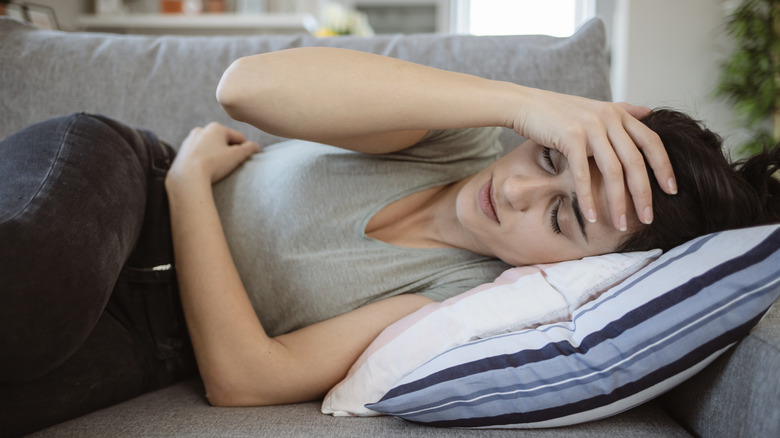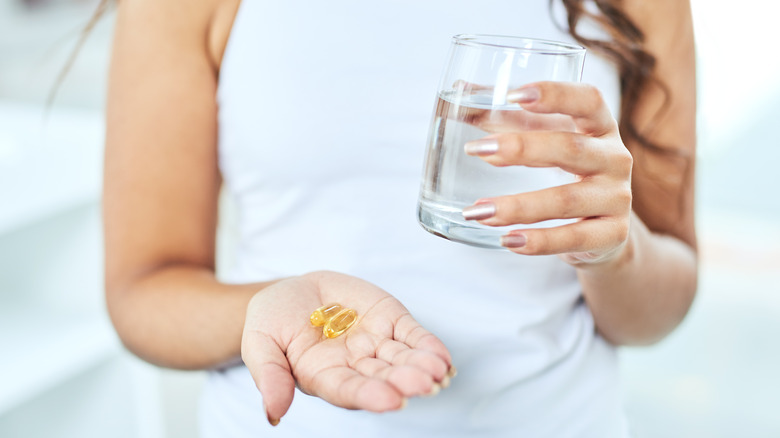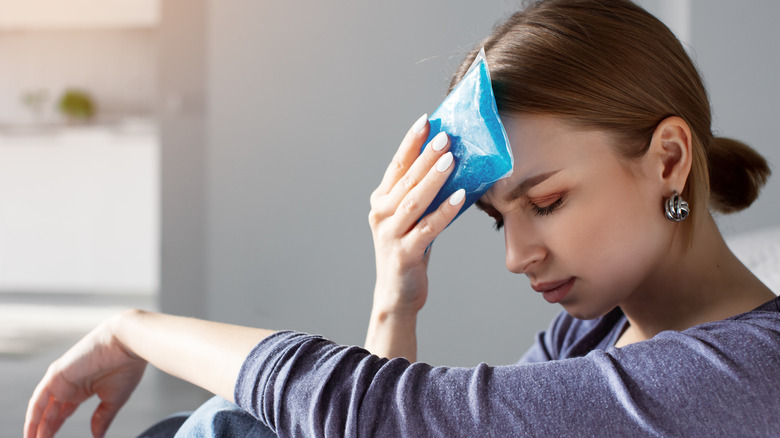Menstrual Migraines Are No Joke - Here's How To Find Some Relief
Everyone's menstrual cycle comes with a slew of different symptoms. From bloating to cramps, our periods' physical symptoms can be no joke in how it impacts our day-to-day life. Some people struggle with menstrual migraines. Menstrual migraines differ from regular headaches because they are triggered by the drop of estrogen your body experiences before your period starts, explains the Cleveland Clinic.
These migraines can happen anywhere from two days before your period starts, up to around the third day of bleeding. The migraines can be incredibly painful and debilitating, making it difficult to work and function. Even more difficult is that menstrual migraines can be hard to treat with normal migraine medication. The American Migraine Foundation explains that although there is still little research to support this theory, it is believed that the changing estrogen levels can cause interference with medications that would normally work at other times.
This information seems to make dealing with menstrual migraines feel impossible. While the best thing you can do is talk to your doctor to find solutions, in the meantime there are some steps you can take to help ease the effects. There are two courses of action you can take: preventative and responsive. Preventative actions are things you can do before your period, while responsive includes things to try during your period should you have a migraine.
Preventative actions
Taking a daily magnesium oxide supplement has shown positive effects in combating symptoms for those who suffer from menstrual migraines, per the American Migraine Foundation. Taking a 400 mg dose pill has been shown to specifically target aura symptoms in migraines, and even prevent them for those who have an irregular cycle. 400 mg of magnesium oxide is also a safe dose for those who are pregnant, making this an easy supplement for anyone to incorporate.
Another suggestion is to focus on your diet leading up to your period. Eating hormone-balancing foods can help regulate your body's hormone levels and ease all period symptoms, not just migraines. Carrots, in particular, are a great food to eat the week before your period because they are high in fiber. This means they are excellent for breaking down and flushing out excess estrogen in your body, according to CNBC.
2019 research from the Journal of Headache and Pain shows that 30 minutes of aerobic exercise at least three days a week had positive effects in helping alleviate migraines. Up to 54% of participants reported a significant decrease in pain. This aerobic exercise does not have to be high intensity — a moderate-paced walk can offer all the same benefits as well. Though staying active on your period sounds like the last thing you want to do, it has been shown to help all period symptoms, not just migraines.
Reactionary actions
Preventing a migraine is not always possible. Should you have one start to come on during your period there are some steps you can take to help manage symptoms. CBD has risen in popularity over the years as it has become legalized in more states. While there are no trials to support that CBD helps with migraines, many users report seeing results. Cove explains that CBD is several hundred times more anti-inflammatory than aspirin, making it a stronger remedy than painkillers alone.
The National Headache Foundation suggests using cold and hot compresses to help lessen the pain of a migraine. Start with 15 minutes of a cold compress on the forehead and temples, then switch to a hot compress for 15 minutes on the neck and back of the head. While this remedy may not stop a migraine, it can help to make the symptoms more tolerable. It is also advised to avoid brightly lit rooms and screens while suffering from menstrual migraines. Light sensitivity is amplified during this time and can bring on other symptoms such as nausea


